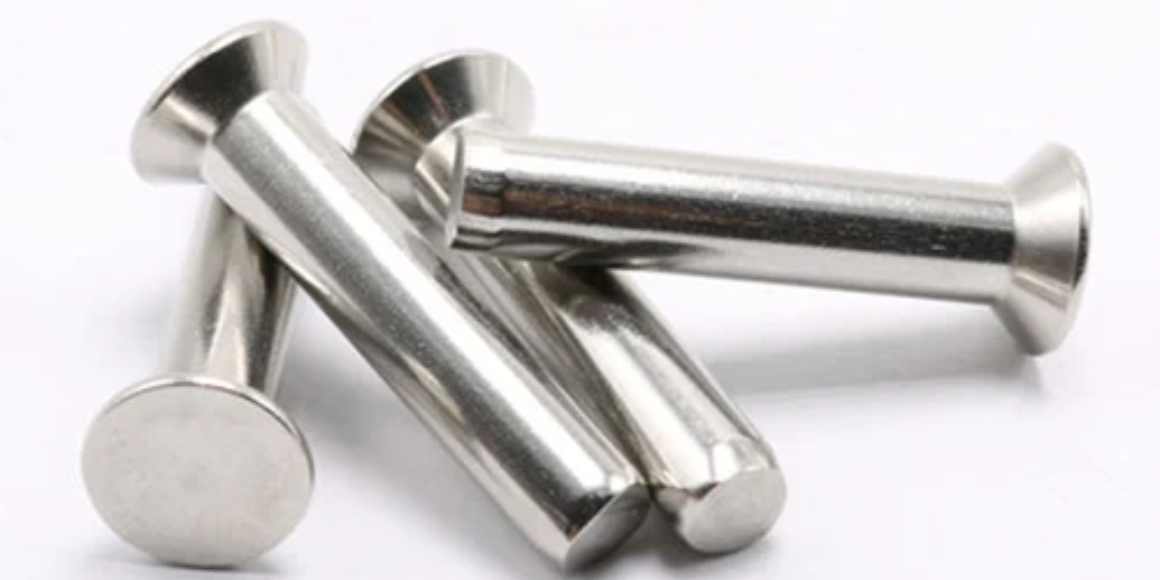
We write a lot about blind rivets, lockbolts, threaded inserts, and other types of fasteners, but we don’t want to overlook solid rivets. Solid rivets are probably the oldest and most reliable type of fastener and have been used for millennia. The ancient Egyptians used rivets to fix clay pots, and the Vikings used them to secure the planking in longboats. With every new application for solid rivets that emerged, new rivet materials were needed.
You may be most familiar with the solid rivets that are used in construction. Large steel rivets are driven into girders to form a lasting joint to support skyscrapers or bridges. You have probably seen videos of construction crews using solid rivets. They insert the rivet into the hole, heat it to soften the material, then flatten it to form the joint using a bucking bar.
You must choose the right rivet material to get the best performance out of it. In our construction example, the crew must heat the rivet to soften it to form a lasting joint. Most solid rivet applications don’t require heating, so you must use materials that can create a strong joint when you flatten it. You may also base your choice of rivet material on the material’s conductive characteristics and ability to resist rust and corrosion.
The Basics of Solid Rivets
Unlike blind rivets that use a hollow shaft and a mandrel to collapse the rivet on the blind side, solid rivets require you to have access to both sides of the material. The rivet has a solid shaft and a head on one side. To set the rivet, you fit it into the pre-drilled hole and strike the head with a hammer or rivet tool while the opposite side flattens against a bucking bar.
When choosing the right type of solid rivet, you want to use a material that is soft enough to be flattened for a secure joint but hard enough to last. Various materials are commonly used for solid rivets; the most common are steel, stainless steel, brass, aluminum, copper, and nickel alloy.
The Pros and Cons of Solid Rivets
Solid rivets have many advantages and disadvantages, depending on the application. Solid rivets are very reliable and form a strong, lasting joint, but you need access to both sides of the joint to install them. With shipbuilding and similar installations, you will need two people: one to hold the bucking bar and one to hammer the rivet.
Blind rivets were developed to deal with this issue. The blind rivet is hollow with a mandrel that can be pulled from one side of the joint to form the bond. There are applications where blind rivets aren’t practical and you want the added strength of a solid rivet.
You don’t need special tools to install solid rivets—all you need is a hammer and a bucking bar. Riveting tools are available to make installation easier, such as for larger construction jobs. Solid rivets are designed for permanent installation and are more difficult to remove than other rivets.
Solid rivets have other characteristics that can be invaluable for specific uses. For example, solid rivets are used in shipbuilding because they are waterproof. Choosing a noncorrosive rivet material, such as stainless steel or brass, also helps resist corrosion.
Options for Solid Rivet Materials
To choose the right solid rivet material, you must understand the available options and their characteristics:
- Steel rivets: Steel rivets are among the most common, and they are used for general applications such as for ships, bridges, and construction projects.
- Stainless steel: Stainless steel rivets combine high tensile strength with a finish that fights corrosion. They are sometimes used in construction, aerospace, and military equipment applications.
- Brass: Brass rivets offer high strength, are corrosion-resistant, and have high thermal and electrical conductivity, so they are used in everything from marine equipment to architecture. They are also highly decorative, which is why they are used in clothing, such as in jeans.
- Aluminum: Aluminum solid rivets have a very high strength-to-weight ratio, so they are used for aerospace, medium-duty equipment, camping gear, and other applications where weight is a factor. They are also nonmagnetic and nonsparking.
- Copper: Copper is a strong, corrosion-resistant, antimicrobial metal that is an excellent electrical and heat conductor. Copper rivets are used in electronics and construction. Copper is also highly decorative, so copper rivets are also used in clothes, shoes, and luggage.
- Nickel alloy: Nickel alloy solid rivets are high-strength rivets often used on boats and for marine applications. Nickel alloy also has a high acid resistance, a higher melting point, and is extremely tough.
You also have different choices in the style of solid rivet heads. There are flat-headed solid rivets, round heads, pan heads, and countersunk heads. You should choose the type of rivet head that gives you the finished look you are seeking. The head size and type dictate the joint's load-bearing surface.
Choosing the right type of solid rivet or rivet materials for any given task isn’t always obvious. Consider factors such as strength, durability, corrosion, weight, and pullout. If you aren’t sure which solid rivet is best for the job, you can always talk to the experts at Bay Supply. And be sure to shop for solid rivets on the Bay Supply Marketplace.



Comments